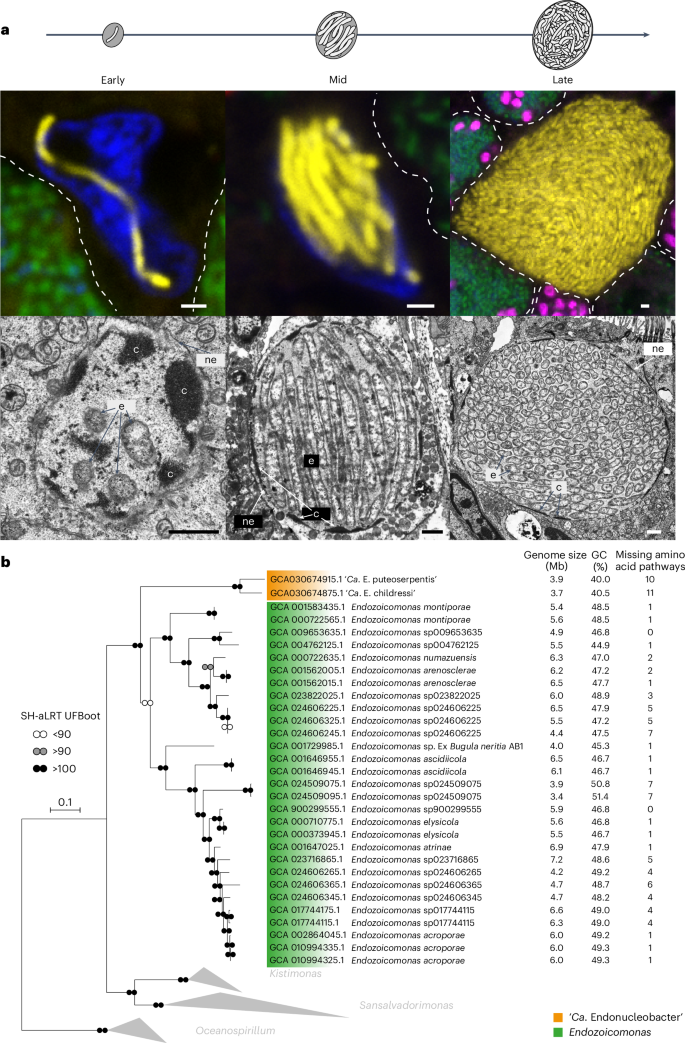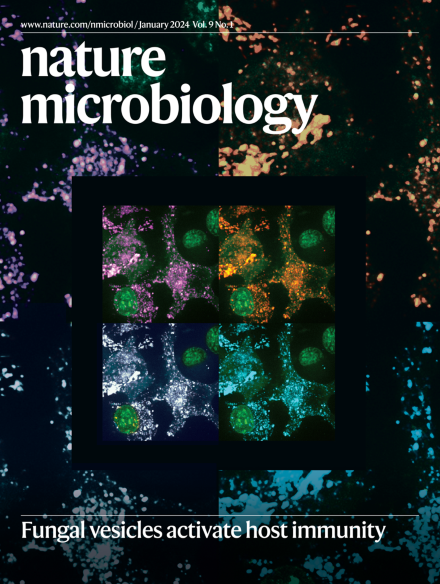An intranuclear bacterial parasite of deep-sea mussels expresses apoptosis inhibitors acquired from its host
IF 20.5
1区 生物学
Q1 MICROBIOLOGY
引用次数: 0
Abstract
A limited number of bacteria are able to colonize the nuclei of eukaryotes. ‘Candidatus Endonucleobacter’ infects the nuclei of deep-sea mussels, where it replicates to ≥80,000 bacteria per nucleus and causes nuclei to swell to 50 times their original size. How these parasites are able to replicate and avoid apoptosis is not known. Dual RNA-sequencing transcriptomes of infected nuclei isolated using laser-capture microdissection revealed that ‘Candidatus Endonucleobacter’ does not obtain most of its nutrition from nuclear DNA or RNA. Instead, ‘Candidatus Endonucleobacter’ upregulates genes for importing and digesting sugars, lipids, amino acids and possibly mucin from its host. It likely prevents apoptosis of host cells by upregulating 7–13 inhibitors of apoptosis, proteins not previously seen in bacteria. Comparative phylogenetic analyses revealed that ‘Ca. Endonucleobacter’ acquired inhibitors of apoptosis through horizontal gene transfer from their hosts. Horizontal gene transfer from eukaryotes to bacteria is assumed to be rare, but may be more common than currently recognized. ‘Candidatus Endonucleobacter’ is a pathogen of deep-sea mussels that can successfully reproduce in the nuclei of its host by expressing inhibitors of apoptosis, likely acquired through horizontal gene transfer.


深海贻贝的核内细菌寄生虫表达从宿主那里获得的细胞凋亡抑制剂
能够在真核生物细胞核中定植的细菌数量有限。内核拟杆菌 "感染深海贻贝的细胞核,每个细胞核复制≥80,000 个细菌,使细胞核膨胀到原来的 50 倍。这些寄生虫如何能够复制并避免凋亡尚不清楚。利用激光捕获显微切割技术分离的受感染细胞核的双 RNA 序列转录组显示,'内核杆菌'的大部分营养并非来自核 DNA 或 RNA。相反,'内核杆菌'会上调从宿主体内输入和消化糖类、脂类、氨基酸以及可能的粘蛋白的基因。它可能通过上调 7-13 种细胞凋亡抑制因子来防止宿主细胞凋亡,这些蛋白以前在细菌中从未见过。系统发育比较分析表明,'Ca.内核细菌'通过宿主的水平基因转移获得了细胞凋亡抑制因子。真核生物向细菌的水平基因转移被认为是罕见的,但可能比目前认识到的更为普遍。
本文章由计算机程序翻译,如有差异,请以英文原文为准。
求助全文
约1分钟内获得全文
求助全文
来源期刊

Nature Microbiology
Immunology and Microbiology-Microbiology
CiteScore
44.40
自引率
1.10%
发文量
226
期刊介绍:
Nature Microbiology aims to cover a comprehensive range of topics related to microorganisms. This includes:
Evolution: The journal is interested in exploring the evolutionary aspects of microorganisms. This may include research on their genetic diversity, adaptation, and speciation over time.
Physiology and cell biology: Nature Microbiology seeks to understand the functions and characteristics of microorganisms at the cellular and physiological levels. This may involve studying their metabolism, growth patterns, and cellular processes.
Interactions: The journal focuses on the interactions microorganisms have with each other, as well as their interactions with hosts or the environment. This encompasses investigations into microbial communities, symbiotic relationships, and microbial responses to different environments.
Societal significance: Nature Microbiology recognizes the societal impact of microorganisms and welcomes studies that explore their practical applications. This may include research on microbial diseases, biotechnology, or environmental remediation.
In summary, Nature Microbiology is interested in research related to the evolution, physiology and cell biology of microorganisms, their interactions, and their societal relevance.
 求助内容:
求助内容: 应助结果提醒方式:
应助结果提醒方式:


